Tree Tinning In Australia
Conservation of Rare Australian Cockatoos
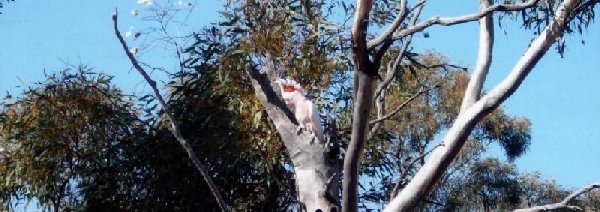
As with many species of birds and animals throughout the world, loss of habitat and competition from other more adaptive species and the general influence of Man on the fine balance of the natural world, is potentially putting them at risk of extinction. We therefore must consider it our duty to help protect them in any way we can. One such method is by ensuring the young from established pairs are kept safe during the very important and vulnerable stages of rearing.
It was during a bush tour of New South Wales and Victoria, Australia, in the early 1990's, which was organised and directed by Ray Ackroyd, a licensed trapper, that he informed members of the Parrot Society UK, namely John Mollindinia and Tom Alston, whom were present on this particular tour, that one of the problems encountered by the Major Mitchell’s Cockatoos (Cacatua Leadbeateri), as it had been noted that not many were present, was the predation of active nesting sites by Goannas, a large monitor lizard, which would climb the tree trunk, enter the nest hole and steal the eggs or chicks, whichever happened to be present.
Goannas are a species of Monitor Lizard, the particular trouble-maker being the Lace Monitor (Varanus Varius), which is the second largest of its group, growing to 2 metres in length and weighing as much as 20kg. They forage over long distances, covering up to 3 km a day feeding on insects, carrion, smaller reptiles, mammals and birds.
Major Mitchell’s Cockatoos prefer lower nesting sites than other birds and particular types of trees known as Mallee trees (this refers to the way in which they grow rather than the species), which seldom grow more than 10 metres in height. This behaviour makes them more vulnerable to attack by ground dwellers that have the ability to climb.
It was during this tour that Ray and John discussed what could be done to prevent the ‘raiding’ of the nesting sites by this method, thus helping the Major Mitchell’s survival rates. Ray came up with the idea of placing a sheet of tin around the tree trunk below the nest hole preventing the predator reaching the nest hole. Ray agreed to trial this idea in a certain area whilst monitoring the population, particularly young birds the following season. The results came back very encouraging, with the local population figures for the Major Mitchell's increased!
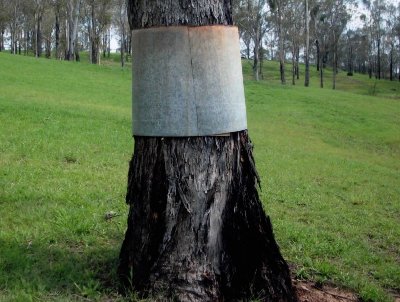
A typical tree with the Tin Band around the main trunk
Whilst Ray began his trial project, John returned to the UK and proposed to the Parrot Society UK Council, that if the results were good, that we should support Ray in his activities by covering the expenses incurred as Ray lives in the Blue Mountains, near Sydney, thus lots of travelling would be required to get to the areas where the Major Mitchell's nested and often in places that had no proper road access. The Parrot Society UK (PSUK) took up this mantle and supported Ray in his activities, with immediate results.
When John Mollindinia died in 2001, the PSUK not only elected to continue to support the project but honour John as the instigator to what can be considered a great success story, by placing a plaque on an active tree, a Curly Mallee (Eucalyptus gillii), within the Tandau farm located several hundred kilometres north of Sydney. This tree is now maintained by the farm estate and still has an active pair of Major Mitchell's Cockatoos using it every season.
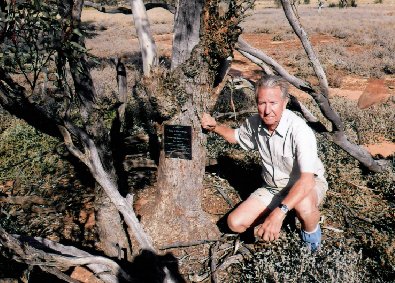
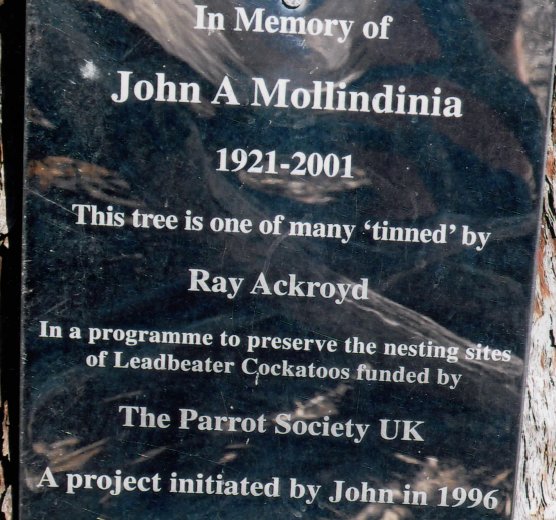
Ray Ackroyd at John's Tree and details written on John's memorial plaque
It is estimated that since this particular tree or John’s Tree as it is more affectionately known, was tinned, over 30 chicks have been successfully raised in it. Following the initial idea by Ray and John, the PSUK now support Ray in the ‘Tinning’ of many trees, in our continued bid to maintain the population of the Major Mitchell’s Cockatoo. Since that time a new heavy duty flat plastic is now available and has proven to be an upgrade on tin. Also clear plastic does not stand out and makes it almost impossible for any person to identify the nest tree. The English Parrot Society (PSUK) is very proud of being able to fund a project to protect one of Australia's most outstanding Cockatoos. The fund has been ongoing for many years thanks to Mr Mollindinia. The Parrot Society attached a plaque at the base of a Major Mitchell's nesting tree in honour of the late John Mollindinia for his outstanding work. During the early part of 2013, the PSUK has learned that the South Australian government is actively supporting the conservation of rare Cockatoos, by offering land owners A$500 for every tree they tin which has been chosen as a nest site by the equally rare and challenged Red Tailed Black Cockatoo (Calyptorhynchus Banksii). In addition the State of Victoria has requested Ray to assist in a campaign to help promote the conservation of the Major Mitchell’s Cockatoo. This project has been awarded A$10,000 and will involve the assistance of school children reporting the location of an active nesting site of the rare cockatoos, for which they will receive A$100.
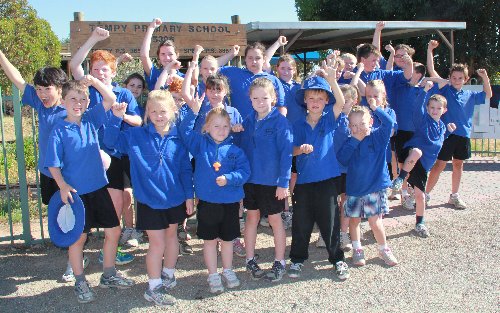
Tempy Primary School Children Celebrating the grant award, and who will be taking part in the spot and report a tree campaign, using Ray's guide for assistance.
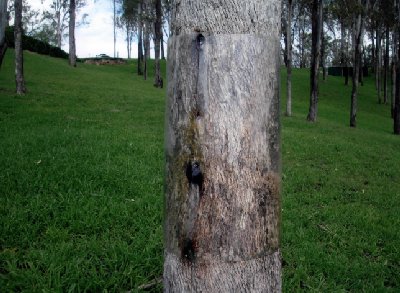
This unique procedure is also being adopted by other conservation groups to help other species whose nests are also being predated by Goannas, Feral Cats, foxes etc.
Update December 2019
Following the devastating bush fires in the Australian drought, Ray Ackroyd sent the following letter to the Parrot Society by way of an update. It makes upsetting reading -
It surprises me just how quickly time slips away and it is appropriate that I should E-Mail you as it's been quite a while since we corresponded. Down here of course and no doubt you have seen it on your news, that we are still in the grip of a severe drought with over 200 individual fires burning our Great Dividing Range, with a great deal fully out of control. The smoke haze along the east coast is like a heavy fog and has lingered for some months. As I write today it is one of our worst days on record.
Most of our large out of control hot fierce fires originate in our National Parks and State Reserves and you may recall what I mentioned at the PS Anniversary last year when I spoke on the loss of Native Wildlife in relation to importance of correct fire management in these huge areas of natural bush and forests. Fire is the greatest predator to Wildlife than any other natural disaster as it takes out all their breeding habitat, their feeding habitat and reduces populations for years to come.
Only last week I observed an area where there were hundreds of Gang - Gang Cockatoos at nest no doubt most with young chicks in those nests. All of those chicks and their nest trees are now gone because of fire and fierce winds. It disappoints me Les to witness that as I've visited that area for many years. I don't think anybody can conceptualise just how many birds, animals and reptiles burn to death and a lot of that falls on to the shoulders of our Government Departments who fail miserably to understand the basic principals of fire management. Sorry to go on about that, however we are only a week into our summer so I expect we haven't seen the last of all that.
As for me personally, well I did once again travel up into the Kimberley Region of Nth West Australia to do a bit of field work on the Finch and Parrot Populations at a lot of the isolated Waterholes in the hills. It is very spectacular country and I still enjoy camping out under the stars there as I have done annually for the past 60 years. I used to have to walk vast distances to find some of those sneaky little permanent Waterholes, but now of course with all the technology I can fly a Drone to find them for me. Certainly saves a lot of hard walking over rough country. Anyway I spent a good 4 weeks up there and I would have to say all of the Nth West bird species populations are in very good numbers. Meanwhile at home here in western Sydney and regardless of the very dry weather I did breed a fair batch of birds, mainly the big Macaws and I do like to breed Queen of Bavarian Conures. I still hand rear them and leave them with the last chick of the season. I don't incubate, but I take the chicks at two or three days.
The reason I do that is because over the years I have found that the first born is usually a number of days ahead of the second born, consequently the first born deprives any other young hatched at a later date the opportunity of being fed by the parent birds so they usually perish and the first born continues to flourish. To rectify all that I just get out of bed and hand raise them. It's a lot of work but in reality you always finish up with a fair season. Another benefit is that I have no problem marketing the young as pets whereas parent raised don't sell well as pets once they fly in the aviary with their parents. I'm sure you know all that.
I also have a fair garden this year even though is hot and dry and because I'm on acres I can work up a fair bit of country. It's a bit hard on my body now but once I get it all sown it's a lot easier. I grow most of the green food I need throughout the breeding season such as Sorgum, corn, French Millet and I have a good variety of fruit trees. Most of all that I cut up and freeze to use for the following season. I also grow a lot of veggies.
I'm still reasonably involved with the nest box programme. I realise that the species involved are not on the threatened list but because of all the Land Clearing and housing infrastructure plus Commercial sites the nesting habitat of the birds has suffered severely. You may recall I had a grant of 1000 English Pounds from the PS and I had respectfully asked if I could use that funding to construct nest boxes and natural logs to assist the local Parrot species to at least find a site to nest, and particularly because all of their past nesting sites in old growth trees had been bulldozed down. Anyway I went ahead with that and the result was excellent with all of the constructed boxes and logs being used. So it's been a great success and I'm forever grateful to the PS for permitting me to use that funding for a conservation project that was urgently needed and is without doubt working very well. Now of course many other Avicultural Societies want to get in on the Bandwaggon as do many of the local Councils and have started erecting nest boxes right across the greater western Sydney Region . Many suburban Schools now have nestboxes in their school grounds. I don't have an issue with that but be sure that the instigator of that successful nest box programme was in fact the English Parrot Society who not only funded it but identified that it needed to be done as a matter of urgency. I will in time let it be known that the PS was the Pioneers of that programme. I will do that when I speak at the next meeting of our Parrot Society.
Reflecting back I have over the past 20 odd years encouraged the Far Western Landholders to tin up positive nesting sites of Major Mitchell Cockatoos to protect their young from being devoured by predators such as native cats and Goannas so I suppose if other organisations want to get in on the local nest box programme then so be it.
Well that's about all I have for you in this novel and I'm still battling with the typing.
Again it's been nice to catch up Les and I admire you for all the effort you put into the Society which seems to be holding its own despite the fact that new members are hard to encourage into the bird fraternity.
Cheers Ray Ackroyd .
See also Artificial Nest Boxes in Australia
